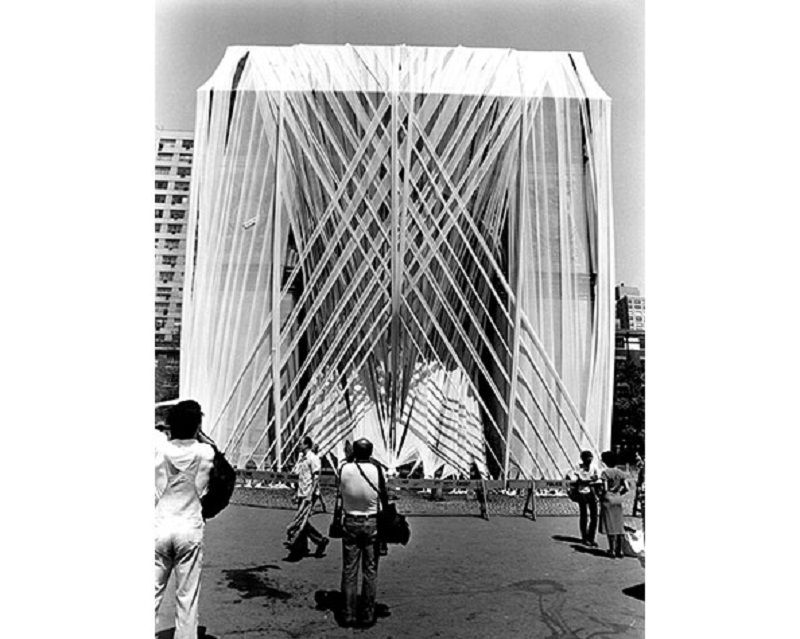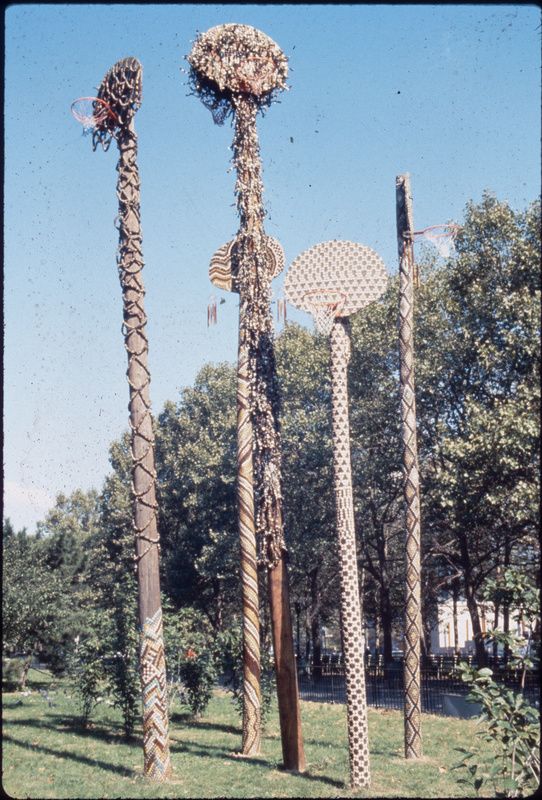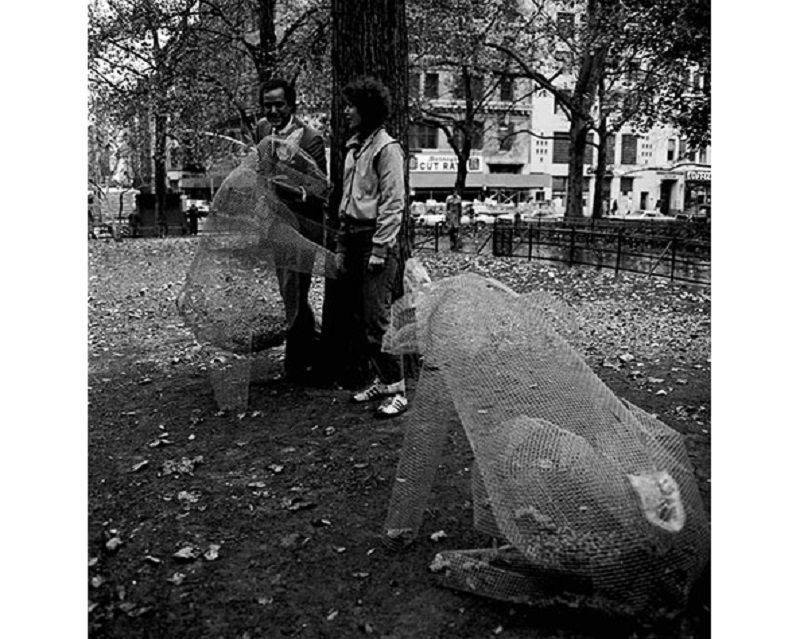Last-Minute NYC Holiday Gift Guide 🎁
We’ve created a holiday gift guide with presents for the intrepid New Yorker that should arrive just in time—


50 years ago, New York City’s Parks, Recreation, and Cultural Affairs Agency first organized the group outdoor exhibit Sculpture in Environment, and from there Art in the Parks took form, gradually expanding as the years went on. In the years since, artists have been able to have their work featured in the city’s parks and reach a wider audience.
Pieces like Robert Indiana’s Love (1971), William Fulbrecht’s Bill of Rights: Access to Government (1990), and Gran Fury’s Petrosino Park Installation (Do Nothing and Stall with Men) (1990) have all spent time featured in the “Art in the Parks” program and helped showcase the city’s talented artists.
Here are 10 more of the most stunning pieces from the history of New York’s “Art in the Parks” to celebrate the program’s 50th anniversary.

Image courtesy NYC Parks Photo Archive.
In 1980, famous artist Francis Hines wrapped New York’s iconic Washington Square Arch in 8,000 yards of polyester gauze. The Washington Square Arch Wrap has become one of the city’s most memorable public displays of art, as it temporarily transformed the familiar monument into a stunning work of art. The display was described as “a giant bandage for a wounded monument.”
Hines’ work was sponsored by NYU and other local community organizations, and was designed to raise funds for the improvement of the monument and surrounding park.

From February 12 to February 28, 2005, artists Christo and Jeanne-Claude’s temporary piece, The Gates, was on display along the pathways of Central Park. The series of 7,503 gates with free-hanging saffron colored fabric panels stretched for 23 miles.
The piece was described as “a golden river appearing and disappearing through the bare branches of the trees.”
Christo and Jeanne-Claude are known for their temporary works of art to “endow the works of art with a feeling of urgency to be seen,” and like their previous works, the entire project was financed by the artist themselves, refusing to accept sponsorship or donations.

David Hammons, Higher Goals, 1986, Mixed Media. Photo by: Pinkney Herbert / Jennifer Secor, Courtesy Public Art Fund, NY
In 1986, artist David Hammons covered five telephone poles with net and over 10,000 bottle caps, and then topped them with a basketball backboard to give the appearance of extremely high basketball nets. The poles were located in Cadman Plaza Park in Brooklyn for a period of time in 1986. The Cadman Plaza Artist-in-Residence Program was an ongoing project of the Public Art Fund and The Rotunda Gallery, and was produced in cooperation with the New York City Department of Parks and Recreation with support from the New York City Department of Cultural Affairs.
Hammons’ three-story tall “basketball hoops” were a statement commenting on the highly unlikely aspirations of escaping inner city ghettos by way of athletics. On his art, Hammons stated, “It takes five to play on a team, but there are thousands who want to play- not everyone will make it, but even if they don’t at least they tried.”
Overall, Higher Goals took Hammons eight weeks to construct.

Image courtesy NYC Parks Photo Archive.
Artist Christy Rupp constructed a pair of wire-mesh sculptures in Manhattan’s City Hall Park in 1978 titled Food Chain Piece: Sculpture of Prey and Predator.
The translucent bear shaped sculptures were infused with nuts and acorns to feed the park’s squirrels, merging prey and predator, and giving the piece it’s subtitle.
Rupp’s Food Chain Piece was sponsored by the Daniel Wolf Gallery, and has been described as an “animal behavioral sculpture.”
In 1997, artist Karin Giusti constructed a functional greenhouse in The Battery that served as the home to 50 rosebushes and intermittently held voter registration during its time in the park.
The greenhouse was in the shape of the White House and featured a large image of a dollar bill across the front of the building. The piece was sponsored by the Lower Manhattan Cultural Council and NYC Department of Parks.
The White House Greenhouse was initially constructed in Hartford, Connecticut in 1995, before being installed in New York City, and was designed to represent “the intricate nature of politics, money and the future of our environment.”
As part of the Arts in the Parks’ 40th anniversary, artist Cameron Gainer constructed a replica of the mythical Loch Ness Monster. Gainer staged the piece in the salt marsh off of Marine Park in Brooklyn.
“Nessie” was available for viewing from October 22 to December 14 of 2007. Forest City Ratner Companies was the sponsor for the project, making Gainer’s vision possible.
Video by Nancy Hwang via YouTube
Hair salons are typically a personal and private activity, yet artist Nancy Hwang often adapts such activities in her pieces by bringing them into a public atmosphere.
Her 2002 piece, S, located in Petrosino Square in Lower Manhattan, brought a hair salon to the public park where Hwang washed hair in an attempt to break down the barriers between the personal and professional aspects of our daily lives.
The installation was available from August 27 to September 21, 2002 and was set up between a circle of potted palm trees to giving the feeling of a true salon.
In 2004, artist Victor Matthews constructed an installation inhabiting The Battery’s three-acre park for Art in the Parks.
Beyond Metamorphosis consisted of nearly 3,000 umbrellas, each hand painted with an individual monarch butterfly. The grid of umbrellas created an impression of a migrating kaleidoscope of butterflies, and according to the artist, was used to “explore themes of transformation, migration, and regeneration.”
The piece was only available for approximately two weeks in the summer of 2004, between June 7 and June 20, but remains one of the most beautiful exhibits from the “Art in the Parks” program.
Martin Creed has become one of Britain’s most well known artists due to his playful, and occasionally provocative pieces.
In 2016, Creed constructed a large billboard in Brooklyn Bridge Park, but unlike the billboards of Times Square, his piece contained the singular word of “understanding,” as opposed to selling a product.
The 10-foot tall letters stretched across a 50-foot long steel beam that rotated 360 degrees. Creed designed a computerized program that would determine the speed and rhythm of the sign’s rotation, constantly changing the perspective on the piece.
Understanding was available between May 4 and October 23 of 2016.
For Art in the Parks 2014, artist Jim Rennert constructed a large 12-foot statue of a businessman in Union Square in Manhattan.
The figure stood looking up to the sky and the Manhattan skyline, and served as an inspiration to every passerby who worked hard to achieve their dreams. Rennart designed the statue to remind us all to “think big.”
The statue was left in Union Square for nearly a year, from June 3, 2014 to May 4, 2015 and was sponsored by The Cavalier Gallery and Union Square Partnership.
With 2017 being Art in the Parks 50th anniversary, it is a great time to check out New York’s wonderful outdoor art exhibits and celebrate with the Parks Department.
Next, check out Historic Plaque Marks the NYC Home of Playwright Lorraine Hansberry, or A Miniature Bridge Made of Pipe Cleaners Now on View by the West Side Highway in Chelsea, NYC. Get in touch with the author on Instagram @mjohnathonrich.
Subscribe to our newsletter